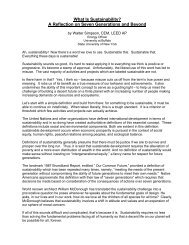Business Guide to Paper Reduction - Tufts Office of Sustainability
Business Guide to Paper Reduction - Tufts Office of Sustainability
Business Guide to Paper Reduction - Tufts Office of Sustainability
You also want an ePaper? Increase the reach of your titles
YUMPU automatically turns print PDFs into web optimized ePapers that Google loves.
Figure 2: Prioritizing <strong>Paper</strong> <strong>Reduction</strong> Activities<br />
Aim for easy successes early on.<br />
This can encourage buy-in and participation. One example could be changing <strong>to</strong> printing<br />
reports only on demand rather than mass distribution.<br />
Identify at least one effort that will involve widespread staff participation and<br />
education.<br />
Often companies begin by encouraging duplex copying or printing, which can take a<br />
sustained effort <strong>to</strong> become embedded in the <strong>of</strong>fice culture, but engages nearly all employees<br />
in learning about paper reduction and developing a culture that supports ongoing paper<br />
reduction efforts<br />
Identify at least one effort that will significantly reduce paper use and costs.<br />
Such efforts may entail a greater initial investment, but will likely have a greater return.<br />
Examples include making forms available on the internet instead <strong>of</strong> pre-printed or providing<br />
online billing <strong>to</strong> cus<strong>to</strong>mers.<br />
The greatest environmental gains can be reached by reducing the number <strong>of</strong> sheets used by the<br />
maximum amount possible and transitioning as much <strong>of</strong> the remaining paper used <strong>to</strong> the highest<br />
level <strong>of</strong> recycled (especially postconsumer) content available with the lowest paper weight<br />
possible <strong>to</strong> still meet the necessary performance standards. This will likely reduce costs from<br />
reduced paper used and lower weight paper. If there is any increase in cost from buying recycled<br />
paper, the costs can be <strong>of</strong>fset by these savings.<br />
G. Start with a pilot project.<br />
Once a company has identified areas <strong>to</strong> focus on for a paper reduction campaign, pilot projects<br />
can be an important fac<strong>to</strong>r in its success. If, for example, a company changes the weight <strong>of</strong> the<br />
paper for a specific use, the paper should be tested thoroughly before high-volume contracts are<br />
signed. Additionally, some companies found it important <strong>to</strong> introduce default duplexing on a<br />
limited number <strong>of</strong> copiers before making the transition throughout the company. Making notes<br />
about how people or machines respond <strong>to</strong> new initiatives will help determine how <strong>to</strong> introduce<br />
them on a larger scale.<br />
H. Encourage involvement.<br />
Encouraging people <strong>to</strong> reduce their paper dependency will take a sustained effort. Developing a<br />
well-targeted education campaign with motivational incentives is key <strong>to</strong> encouraging staff<br />
participation. Below are suggestions for motivation and education strategies:<br />
<strong>Business</strong> <strong>Guide</strong> <strong>to</strong> <strong>Paper</strong> <strong>Reduction</strong> 12







